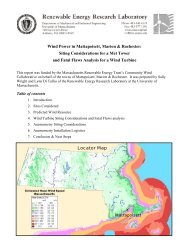Erickson-Indiana-bat
Erickson-Indiana-bat
Erickson-Indiana-bat
Create successful ePaper yourself
Turn your PDF publications into a flip-book with our unique Google optimized e-Paper software.
Habitat occurrence of maternity sites for each grid cell was modeled with a logistic<br />
regression. We built upon previous work to identify covariates to consider (Loeb &<br />
Winters, 2012; Weber & Sparks, 2013; Farmer, Cade & Stauffer, 2002; Miller et al., 2002;<br />
Yates & Muzika, 2006). We initially compared several models that included different<br />
combinations of mean monthly temperature, different mean monthly precipitations, land<br />
cover, mean elevation, and maximum slope. We used the Watanabe Akaike information<br />
criterion (WAIC) for our model selection (Watanabe, 2010) because this method is fully<br />
Bayesian and considers parameter distributions unlike other model selection approaches<br />
(Gelman et al., 2013). We used Stan (version 2.4, http://www.mc-stan.org), as implemented<br />
through RStan, to fit our models and calculate the WAIC values (Hoffman & Gelman, 2014).<br />
Our final model included crop cover, deciduous forest cover, and May precipitation. The<br />
complete parameter values for this model are described in our TRACE documentation<br />
(Supplemental Information 3).<br />
We used the WNS-spread Map from 12 March 2015 (https://www.whitenosesyndrome.<br />
org/resources/map) to model spread of the disease through time. We modeled WNS<br />
(the disease), rather than Pseudogymnoascus destructans (the fungus) because this is what<br />
the North American WNS response group tracks. We assumed that any hibernaculum<br />
without WNS would have WNS by 2016 because WNS has spread across the entire range<br />
of the <strong>Indiana</strong> <strong>bat</strong>. We adapted the white-nose syndrome model used in Thogmartin et<br />
al. (2012b) to be a continuous time function rather than a piecewise discrete function.<br />
We used a logistic function to describe <strong>bat</strong> survival from WNS through time (Bolker,<br />
2008). The model depended upon the baseline winter survival rate and the arrival year of<br />
white-nose syndrome, and also included a slope term and intercept term. The intercept<br />
term is offset by the arrival year term to account for WNS arriving during different<br />
years and we included three different intercept terms to account different WNS survival<br />
scenarios. Parameter were based upon our parameterization as described in the TRACE<br />
Documentation (Supplemental Information 3).<br />
We modeled the effect of wind turbines on the <strong>Indiana</strong> <strong>bat</strong> by decreasing survival based<br />
upon the number of turbines found along a migratory pathway or in a maternity site or<br />
hibernaculum grid cell. The number of turbines present decreased the baseline survival.<br />
Due to uncertainty about the number of <strong>bat</strong>s killed by turbines (Arnett & Baerwald, 2013),<br />
we used three mortality scenarios: A low mortality scenario with 1 of 1,000 <strong>bat</strong>s flying<br />
by a turbine killed, a medium mortality scenario with one out of 100 <strong>bat</strong>s flying by a<br />
turbine killed, and a high mortality scenario with one out of 10 <strong>bat</strong>s flying by a turbine<br />
killed. These three scenarios were chosen to bound the spectrum of possible responses and<br />
accommodate uncertainty in <strong>Indiana</strong> <strong>bat</strong> mortality at turbines, as well as include a ‘‘safety<br />
factor’’ consideration (Suter II, 2006). This uncertainty in mortality exists because, to date,<br />
only 7 <strong>Indiana</strong> <strong>bat</strong>s have been reported killed at wind energy facilities to the USFWS (Fig. 2;<br />
http://www.fws.gov/midwest/wind/wildlifeimpacts/inbafatalities.html). The medium and<br />
high scenarios are unlikely to be an average (or ‘‘expected’’) mortality rate for all migratory<br />
pathways, but represent worst case collisions risks for <strong>bat</strong>s flying through turbines. The<br />
actual collision risk for any specific wind turbine and an <strong>Indiana</strong> <strong>bat</strong> likely depends upon<br />
many local environmental conditions that change temporally (e.g., wind direction during<br />
<strong>Erickson</strong> et al. (2016), PeerJ, DOI 10.7717/peerj.2830 5/19



